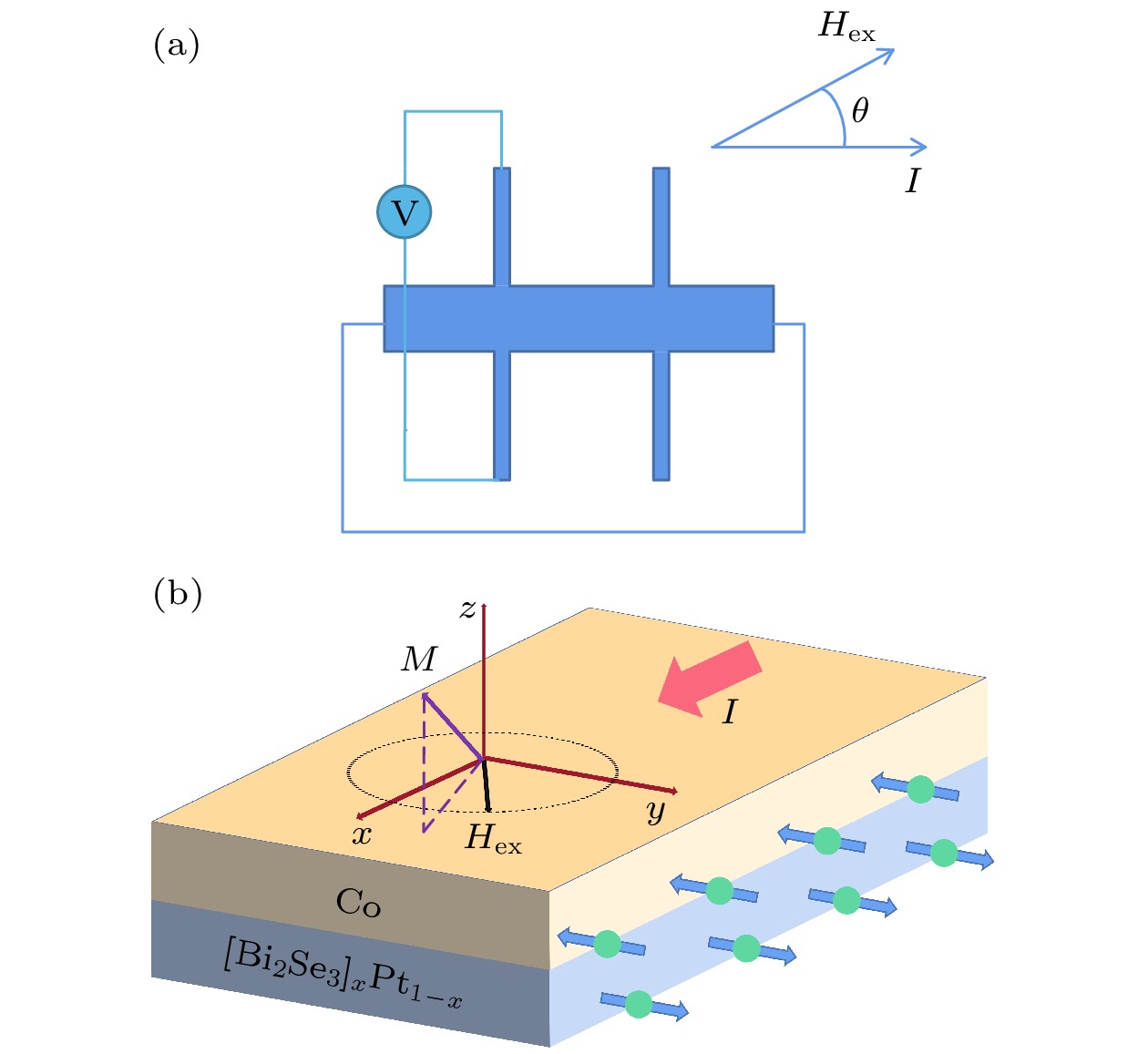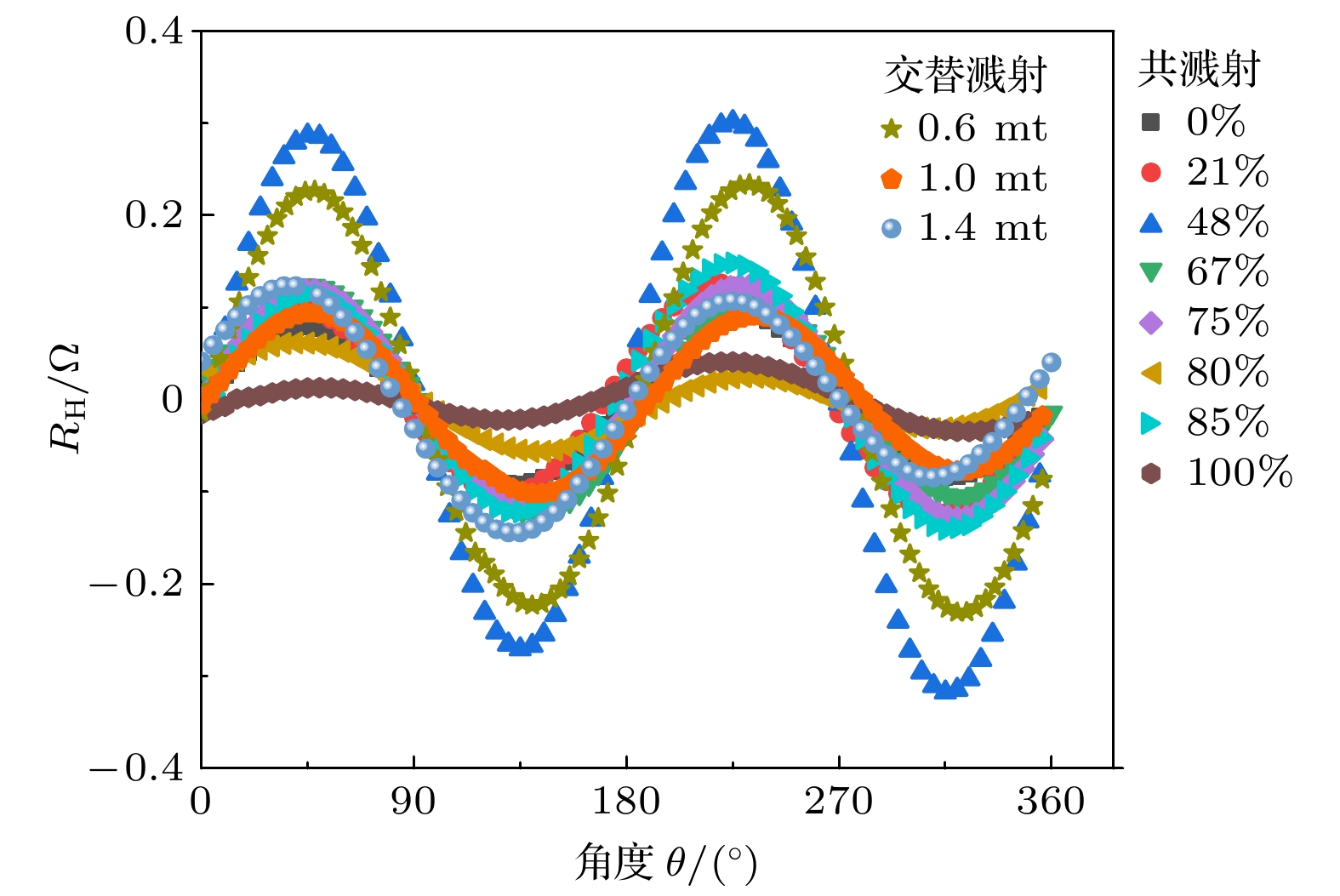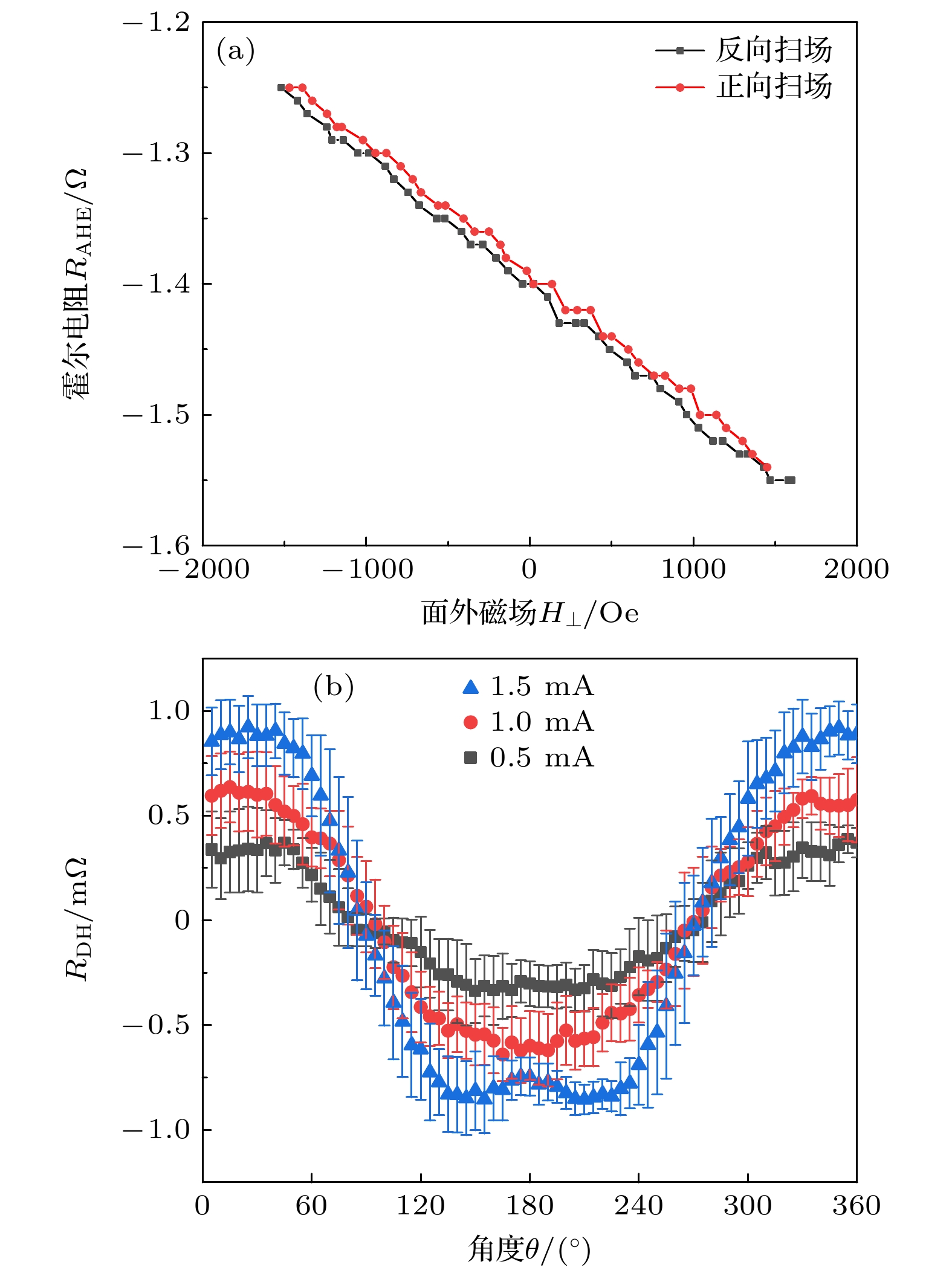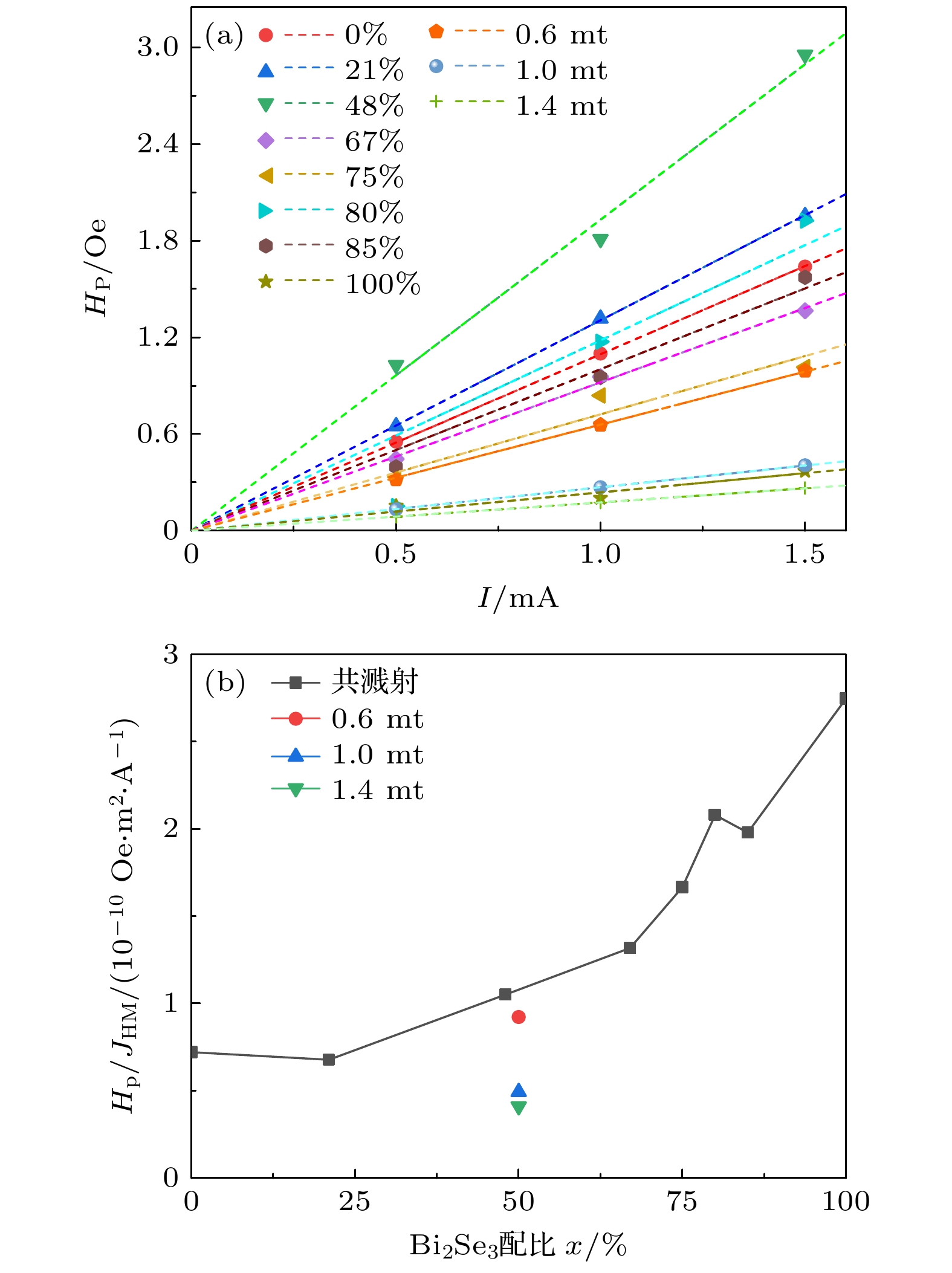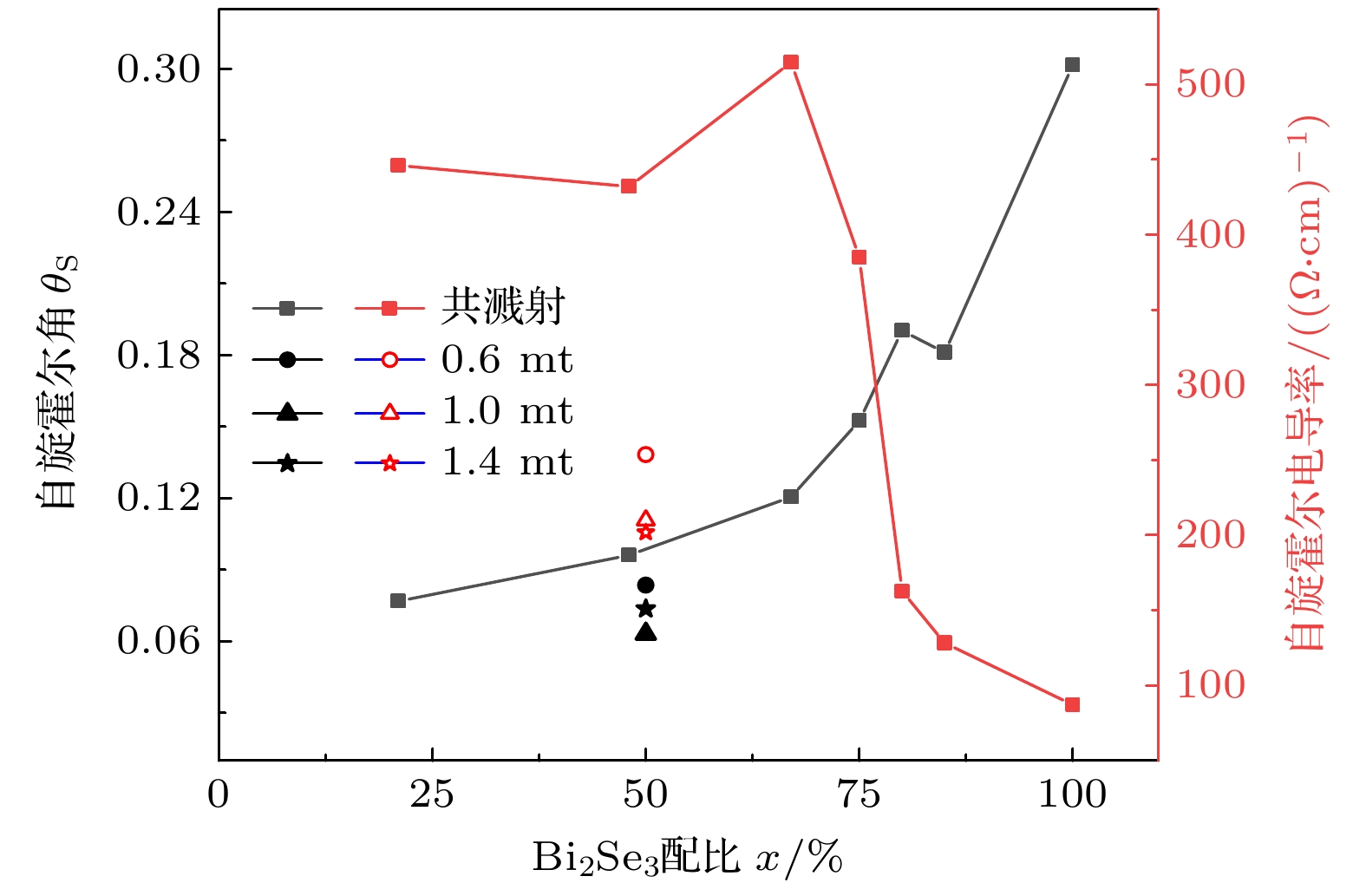-
自旋轨道转矩器件实现快速高效的磁性操作, 需要提供自旋流的强自旋轨道耦合层具有高的电荷-自旋密度转换效率, 以及低的电阻率. 本文采用磁控溅射方法生长具有面内磁性的BiSePt合金/Co异质结构, 对比BiSePt合金采用共溅射及交替溅射两种生长方式, 研究了不同配比下的自旋轨道转矩效率(SOT效率)与合金电阻率. Pt掺杂提高了合金层的金属性, 但是逐渐破坏Bi2Se3非晶表面的拓扑序, 随着Pt组分的增加, 两种竞争的机制使得合金层的自旋霍尔电导率随浓度配比有非单调变化, 并且在Bi2Se3组分为67%的配比处达到了优值. 相比共溅射方式, 交替溅射方式生长合金层的电导率及自旋霍尔角较小, 这归因于界面散射的增强及Pt对自旋流的过滤效应. 相比于传统的纯重金属Pt和Ta等, 以及拓扑绝缘体Bi2Se3等材料, 我们的BiSePt合金实现了与工业匹配的生长条件, 较高的SOT效率, 以及适中的电阻率, 对于SOT器件的实际应用很有意义.In order to achieve high-efficiency spin-orbit torque devices, higher charge-spin conversion efficiency, and lower resistivity are required in the strong spin-orbit coupling layer that provides the spin current. In this work we prepare BiSePt alloy/Co heterostructures with in-plane magnetic anisotropy by magnetron sputtering deposition. The alloy layer is deposited via one of two procedures, either co-sputtering or alternative-sputtering. We study the BiSePt alloy samples and find that the spin orbit torque (SOT) efficiency decreases with the increase of Pt component, which is attributed to the change of topological order of Bi2Se3 amorphous surface, caused by Pt doping. And the resistivity decreases with the increase of Pt component, which depends on the increase of metallic property. Due to the balance of these two competing mechanisms, the spin Hall conductivity of the alloy layer varies non-monotonically with the concentration ratio, and reach an optimal value at a ratio of 67% of Bi2Se3 component. With the increase of the Bi2Se3 component, the SOT efficiency, electrical resistivity and spin Hall conductance of the alloy layer show different trends. At about 20%–70%, they increase/decrease tardily. At about 70%–100%, the resistivity ascends more prominently than the SOT efficiency, which leads the spin Hall conductance to decrease. Comparing with using the co-sputtering deposition, the electrical conductivity and spin Hall angle of the alloy layer obtained using alternating sputtering deposition are small, which is attributed to the enhancing of interfacial scattering and the filter effect of Pt on the spin flow. In contrast to traditional pure heavy metal materials (such as Pt, Ta) and topological insulator materials like Bi2Se3, our BiSePt alloy devices obtained by co-sputtering deposition achieve industry-matched preparation conditions, greater SOT efficiency, and considerable electrical conductivity of the alloy layer, thus making further applications of SOT devices possible.
-
Keywords:
- spin orbit torque /
- BiSePt alloy /
- spin Hall angle
[1] Dieny B, Prejbeanu I L, Garello K, et al. 2020 Nat. Electron. 3 446
 Google Scholar
Google Scholar
[2] Ralph D C, Stiles M D 2008 J. Magn. Magn. Mater. 320 1190
 Google Scholar
Google Scholar
[3] Manchon A, Železný J, Miron I M, Jungwirth T, Sinova J, Thiaville A, Garello K, Gambardella P 2019 Rev. Mod. Phys. 91 035004
 Google Scholar
Google Scholar
[4] Cao Y, Xing G Z, Lin H A, Zhang N, Zheng H Z, Wang K Y 2020 iScience 23 101614
 Google Scholar
Google Scholar
[5] Cai K M, Yang M Y, Ju H L, Wang S M, Ji Y, Li B, Edmonds K W, Sheng Y, Zhang B, Zhang N, Liu S, Zheng H Z, Wang K Y 2017 Nat. Mater. 16 712
 Google Scholar
Google Scholar
[6] Cao Y, Sheng Y, Edmonds K W, Ji Y, Zheng H Z, Wang K Y 2020 Adv. Mater. 32 1907929
 Google Scholar
Google Scholar
[7] Sheng Y, Edmonds K W, Ma X Q, Zheng H Z, Wang K Y 2018 Adv. Electron. Mater. 4 1800224
 Google Scholar
Google Scholar
[8] Kurenkov A, DuttaGupta S, Zhang C L, Fukami S, Horio Y, Ohno H 2019 Adv. Mater. 31 1900636
 Google Scholar
Google Scholar
[9] Cao Y, Rushforth A, Sheng Y, Zheng H Z, Wang K Y 2019 Adv. Funct. Mater. 29 1808104
 Google Scholar
Google Scholar
[10] Sheng Y, Li Y C, Ma X Q, Wang K Y 2018 Appl. Phys. Lett. 113 112406
 Google Scholar
Google Scholar
[11] Qiu X P, Shi Z, Fan W J, Zhou S M, Yang H 2018 Adv. Mater. 30 1705699
 Google Scholar
Google Scholar
[12] Yang M Y, Cai K M, Ju H L, Edmonds K W, Yang G, Liu S, Li B H, Zhang B, Sheng Y, Wang S G, Ji Y, Wang K Y 2016 Sci. Rep. 6 20778
 Google Scholar
Google Scholar
[13] Miron I M, Garello K, Gaudin G, Zermatten P J, Costache M V, Auffret S, Bandiera S, Rodmacq B, Schuhl A, Gambardella P 2011 Nature 476 189
 Google Scholar
Google Scholar
[14] Liu L Q, Pai C F, Li Y, Tseng H W, Ralph D C, Buhrman R A 2012 Science 336 555
 Google Scholar
Google Scholar
[15] Mihai Miron I, Gaudin G, Auffret S, Rodmacq B, Schuhl A, Pizzini S, Vogel J, Gambardella P 2010 Nat. Mater. 9 230
 Google Scholar
Google Scholar
[16] Li Y C, Edmonds K W, Liu X H, Zheng H Z, Wang K Y 2019 Adv. Quantum Technol. 2 1800052
 Google Scholar
Google Scholar
[17] Ye X G, Zhu P F, Xu W Z, Shang N, Liu K, Liao Z M 2022 Chin. Phys. Lett. 39 037303
 Google Scholar
Google Scholar
[18] Fukami S, Zhang C L, DuttaGupta S, Kurenkov A, Ohno H 2016 Nat. Mater. 15 535
 Google Scholar
Google Scholar
[19] Li C H, van’t Erve O M J, Robinson J T, Liu Y, Li L, Jonker B T 2014 Nat. Nanotechnol. 9 218
 Google Scholar
Google Scholar
[20] Han J H, Richardella A, Siddiqui S A, Finley J, Samarth N, Liu L Q 2017 Phys. Rev. Lett. 119 077702
 Google Scholar
Google Scholar
[21] Dc M, Grassi R, Chen J Y, Jamali M, Reifsnyder H D, Zhang D L, Zhao Z Y, Li H S, Quarterman P, Lü Y, Li M, Manchon A, Mkhoyan K A, Low T, Wang J P 2018 Nat. Mater. 17 800
 Google Scholar
Google Scholar
[22] Khang N H D, Ueda Y, Hai P N 2018 Nat. Mater. 17 808
 Google Scholar
Google Scholar
[23] Sun Y, Zhang Y, Felser C, Yan B H 2016 Phys. Rev. Lett. 117 146403
 Google Scholar
Google Scholar
[24] Wang Y, Zhu D P, Wu Y, Yang Y M, Yu J W, Ramaswamy R, Mishra R, Shi S, Elyasi M, Teo K L, Wu Y H, Yang H 2017 Nat. Commun. 8 1364
 Google Scholar
Google Scholar
[25] Bekele Z A, Liu X H, Cao Y, Wang K Y 2020 Adv. Electron. Mater. 7 2000793
 Google Scholar
Google Scholar
[26] Bekele Z A, Li R Z, Li Y C, Cao Y, Liu X H, Wang K Y 2021 Adv. Electron. Mater. 7 2100528
 Google Scholar
Google Scholar
[27] Zhang E Z, Deng Y C, Li W H, Liu X H, Wang K Y 2022 Phys. Status. Solidi. A 219 2200498
 Google Scholar
Google Scholar
[28] Zhu L J, Ralph D C, Buhrman R A 2021 Appl. Phys. Rev. 8 031308
 Google Scholar
Google Scholar
[29] Chi Z D, Lau Y C, Kawaguchi M, Hayashi M 2021 APL Materials 9 061111
 Google Scholar
Google Scholar
[30] Kawaguchi M, Shimamura K, Fukami S, Matsukura F, Ohno H, Moriyama T, Chiba D, Ono T 2013 Appl. Phys. Express 6 113002
 Google Scholar
Google Scholar
[31] Slonczewski J C 1996 J. Magn. Magn. Mater. 159 L1
 Google Scholar
Google Scholar
[32] Liu L Q, Lee O J, Gudmundsen T J, Ralph D C, Buhrman R A 2012 Phys. Rev. Lett. 109 096602
 Google Scholar
Google Scholar
[33] Plekhanov E, Weber C 2019 Phys. Rev. B 100 115161
 Google Scholar
Google Scholar
[34] Wang C T, Cheng T, Liu Z R, Liu F, Huang H Q 2022 Phys. Rev. Lett. 128 056401
 Google Scholar
Google Scholar
[35] Corbae P, Ciocys S, Varjas D, Kennedy E, Zeltmann S, Molina-Ruiz M, Griffin S M, Jozwiak C, Chen Z H, Wang L W, Minor A M, Scott M, Grushin A G, Lanzara A, Hellman F 2023 Nat. Mater. 22 200
 Google Scholar
Google Scholar
-
图 1 合金层[Bi2Se3]xPt1–x电阻率图, 纵轴为对数坐标. 电阻率随Bi2Se3的配比x的增加而显著上升, mt后缀表示合金层为交替溅射生长
Fig. 1. Resistivity diagram of the alloy layer [Bi2Se3]xPt1–x, with logarithmic scale in the vertical axis. The resistivity increases significantly as partition ration x of Bi2Se3 increases. The suffix “mt” indicates alternating sputtering growth for the alloy layer.
图 2 (a) 霍尔器件的测量示意图 (θ为外磁场与电流的夹角, 其中理想情况下Hex在器件平面内); (b) SOT结构示意图, 显示了自旋流、外磁场Hex与磁化M的偏差
Fig. 2. (a) Measurement scheme of the Hall device (θ is the angle between the current and Hex, which lies in the device plane in the ideal situation); (b) schematic structure of the SOT, shows the spin flow and the deviation between Hex and magnetization M.
-
[1] Dieny B, Prejbeanu I L, Garello K, et al. 2020 Nat. Electron. 3 446
 Google Scholar
Google Scholar
[2] Ralph D C, Stiles M D 2008 J. Magn. Magn. Mater. 320 1190
 Google Scholar
Google Scholar
[3] Manchon A, Železný J, Miron I M, Jungwirth T, Sinova J, Thiaville A, Garello K, Gambardella P 2019 Rev. Mod. Phys. 91 035004
 Google Scholar
Google Scholar
[4] Cao Y, Xing G Z, Lin H A, Zhang N, Zheng H Z, Wang K Y 2020 iScience 23 101614
 Google Scholar
Google Scholar
[5] Cai K M, Yang M Y, Ju H L, Wang S M, Ji Y, Li B, Edmonds K W, Sheng Y, Zhang B, Zhang N, Liu S, Zheng H Z, Wang K Y 2017 Nat. Mater. 16 712
 Google Scholar
Google Scholar
[6] Cao Y, Sheng Y, Edmonds K W, Ji Y, Zheng H Z, Wang K Y 2020 Adv. Mater. 32 1907929
 Google Scholar
Google Scholar
[7] Sheng Y, Edmonds K W, Ma X Q, Zheng H Z, Wang K Y 2018 Adv. Electron. Mater. 4 1800224
 Google Scholar
Google Scholar
[8] Kurenkov A, DuttaGupta S, Zhang C L, Fukami S, Horio Y, Ohno H 2019 Adv. Mater. 31 1900636
 Google Scholar
Google Scholar
[9] Cao Y, Rushforth A, Sheng Y, Zheng H Z, Wang K Y 2019 Adv. Funct. Mater. 29 1808104
 Google Scholar
Google Scholar
[10] Sheng Y, Li Y C, Ma X Q, Wang K Y 2018 Appl. Phys. Lett. 113 112406
 Google Scholar
Google Scholar
[11] Qiu X P, Shi Z, Fan W J, Zhou S M, Yang H 2018 Adv. Mater. 30 1705699
 Google Scholar
Google Scholar
[12] Yang M Y, Cai K M, Ju H L, Edmonds K W, Yang G, Liu S, Li B H, Zhang B, Sheng Y, Wang S G, Ji Y, Wang K Y 2016 Sci. Rep. 6 20778
 Google Scholar
Google Scholar
[13] Miron I M, Garello K, Gaudin G, Zermatten P J, Costache M V, Auffret S, Bandiera S, Rodmacq B, Schuhl A, Gambardella P 2011 Nature 476 189
 Google Scholar
Google Scholar
[14] Liu L Q, Pai C F, Li Y, Tseng H W, Ralph D C, Buhrman R A 2012 Science 336 555
 Google Scholar
Google Scholar
[15] Mihai Miron I, Gaudin G, Auffret S, Rodmacq B, Schuhl A, Pizzini S, Vogel J, Gambardella P 2010 Nat. Mater. 9 230
 Google Scholar
Google Scholar
[16] Li Y C, Edmonds K W, Liu X H, Zheng H Z, Wang K Y 2019 Adv. Quantum Technol. 2 1800052
 Google Scholar
Google Scholar
[17] Ye X G, Zhu P F, Xu W Z, Shang N, Liu K, Liao Z M 2022 Chin. Phys. Lett. 39 037303
 Google Scholar
Google Scholar
[18] Fukami S, Zhang C L, DuttaGupta S, Kurenkov A, Ohno H 2016 Nat. Mater. 15 535
 Google Scholar
Google Scholar
[19] Li C H, van’t Erve O M J, Robinson J T, Liu Y, Li L, Jonker B T 2014 Nat. Nanotechnol. 9 218
 Google Scholar
Google Scholar
[20] Han J H, Richardella A, Siddiqui S A, Finley J, Samarth N, Liu L Q 2017 Phys. Rev. Lett. 119 077702
 Google Scholar
Google Scholar
[21] Dc M, Grassi R, Chen J Y, Jamali M, Reifsnyder H D, Zhang D L, Zhao Z Y, Li H S, Quarterman P, Lü Y, Li M, Manchon A, Mkhoyan K A, Low T, Wang J P 2018 Nat. Mater. 17 800
 Google Scholar
Google Scholar
[22] Khang N H D, Ueda Y, Hai P N 2018 Nat. Mater. 17 808
 Google Scholar
Google Scholar
[23] Sun Y, Zhang Y, Felser C, Yan B H 2016 Phys. Rev. Lett. 117 146403
 Google Scholar
Google Scholar
[24] Wang Y, Zhu D P, Wu Y, Yang Y M, Yu J W, Ramaswamy R, Mishra R, Shi S, Elyasi M, Teo K L, Wu Y H, Yang H 2017 Nat. Commun. 8 1364
 Google Scholar
Google Scholar
[25] Bekele Z A, Liu X H, Cao Y, Wang K Y 2020 Adv. Electron. Mater. 7 2000793
 Google Scholar
Google Scholar
[26] Bekele Z A, Li R Z, Li Y C, Cao Y, Liu X H, Wang K Y 2021 Adv. Electron. Mater. 7 2100528
 Google Scholar
Google Scholar
[27] Zhang E Z, Deng Y C, Li W H, Liu X H, Wang K Y 2022 Phys. Status. Solidi. A 219 2200498
 Google Scholar
Google Scholar
[28] Zhu L J, Ralph D C, Buhrman R A 2021 Appl. Phys. Rev. 8 031308
 Google Scholar
Google Scholar
[29] Chi Z D, Lau Y C, Kawaguchi M, Hayashi M 2021 APL Materials 9 061111
 Google Scholar
Google Scholar
[30] Kawaguchi M, Shimamura K, Fukami S, Matsukura F, Ohno H, Moriyama T, Chiba D, Ono T 2013 Appl. Phys. Express 6 113002
 Google Scholar
Google Scholar
[31] Slonczewski J C 1996 J. Magn. Magn. Mater. 159 L1
 Google Scholar
Google Scholar
[32] Liu L Q, Lee O J, Gudmundsen T J, Ralph D C, Buhrman R A 2012 Phys. Rev. Lett. 109 096602
 Google Scholar
Google Scholar
[33] Plekhanov E, Weber C 2019 Phys. Rev. B 100 115161
 Google Scholar
Google Scholar
[34] Wang C T, Cheng T, Liu Z R, Liu F, Huang H Q 2022 Phys. Rev. Lett. 128 056401
 Google Scholar
Google Scholar
[35] Corbae P, Ciocys S, Varjas D, Kennedy E, Zeltmann S, Molina-Ruiz M, Griffin S M, Jozwiak C, Chen Z H, Wang L W, Minor A M, Scott M, Grushin A G, Lanzara A, Hellman F 2023 Nat. Mater. 22 200
 Google Scholar
Google Scholar
计量
- 文章访问数: 6086
- PDF下载量: 131
- 被引次数: 0













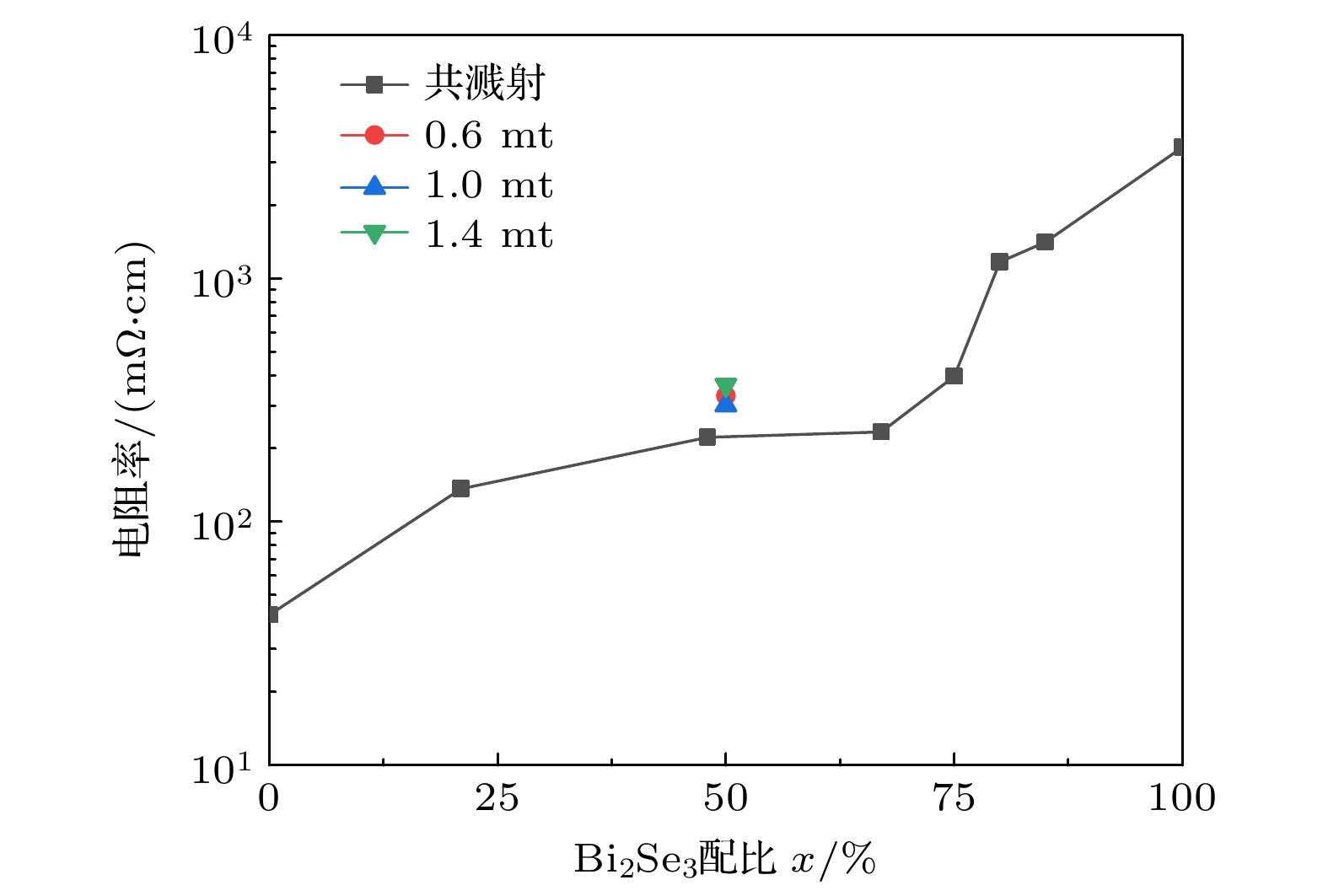
 下载:
下载:
